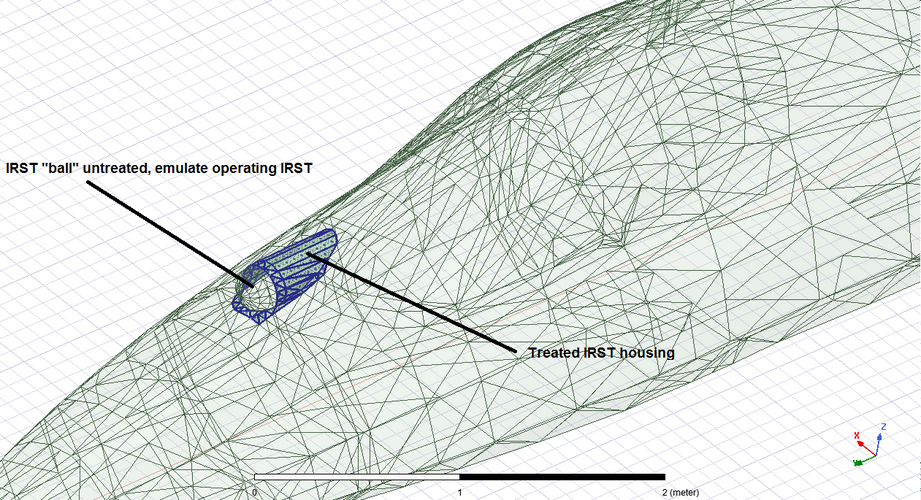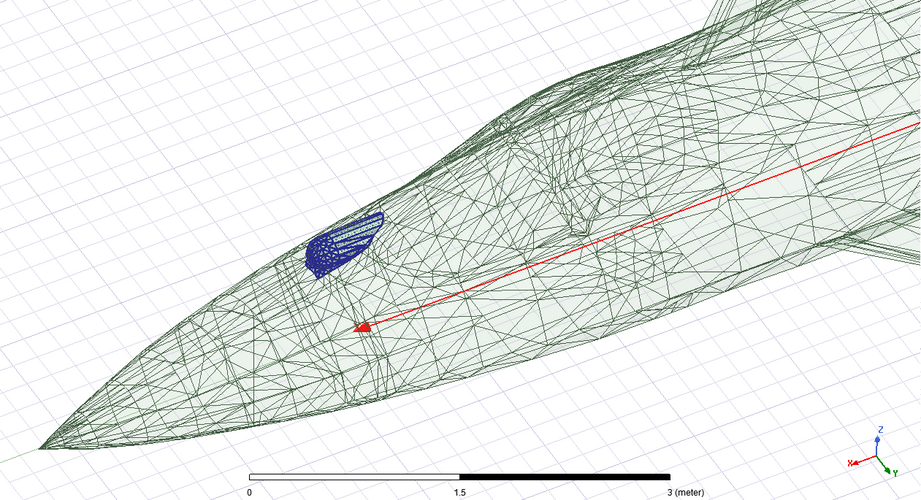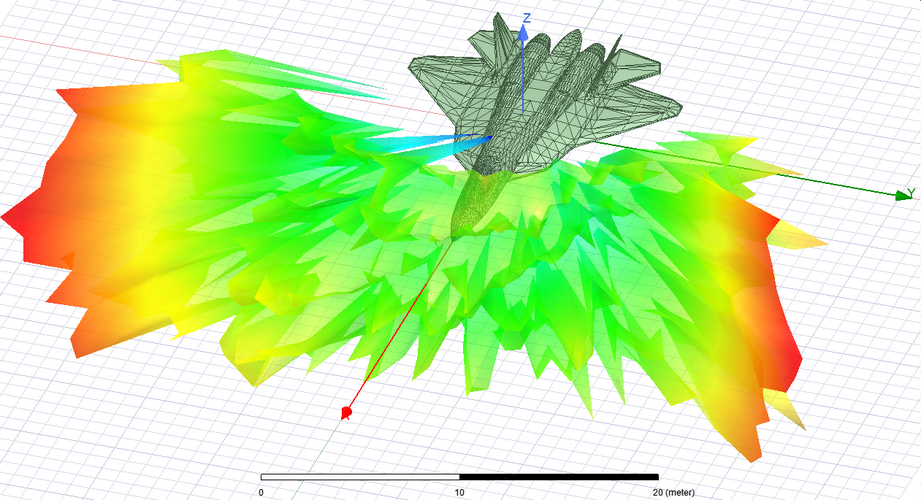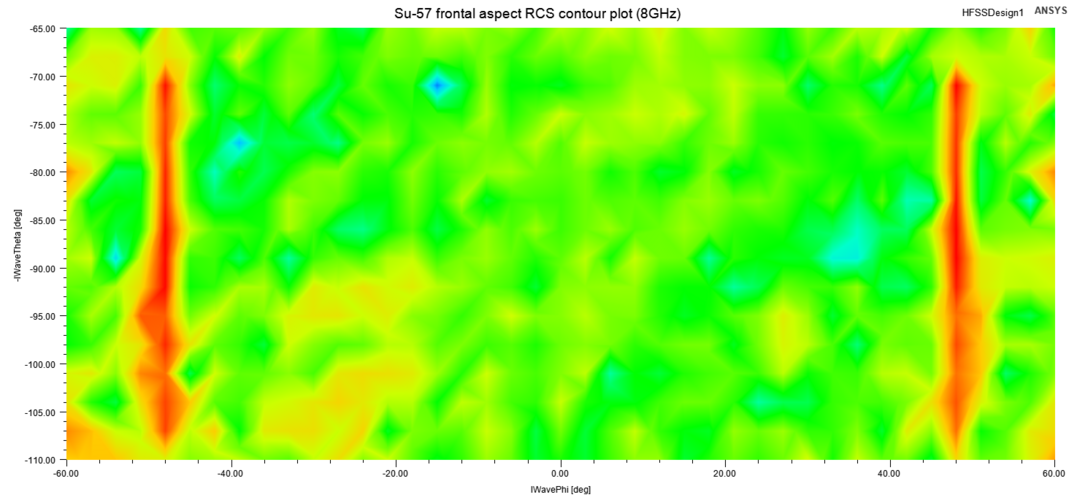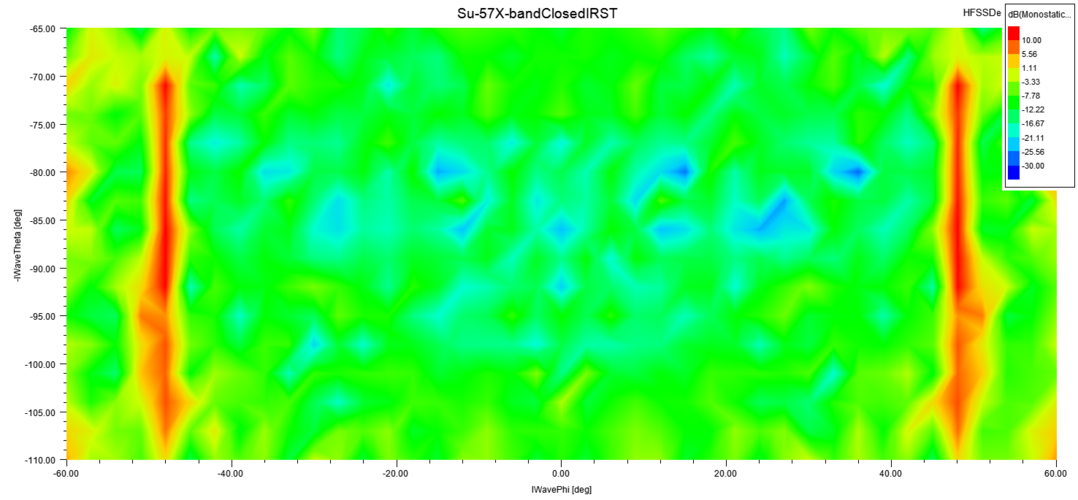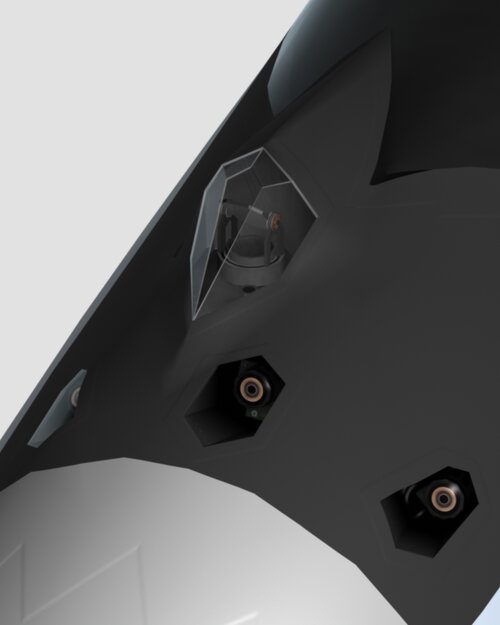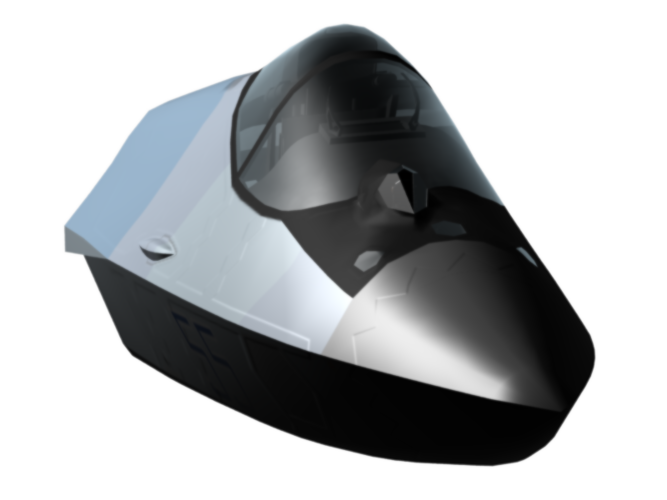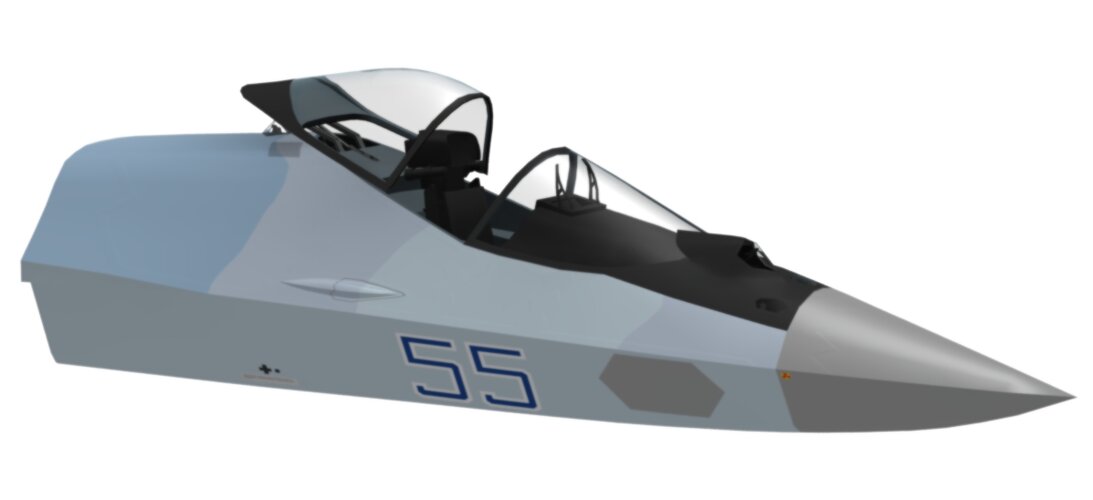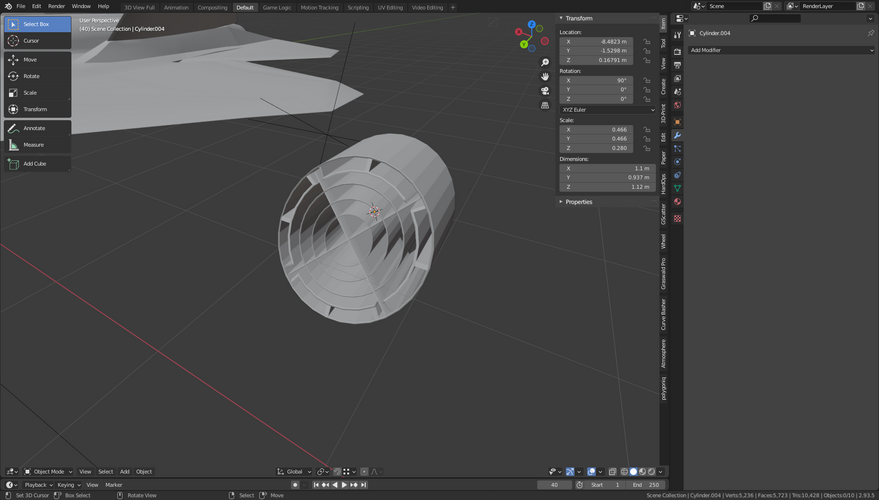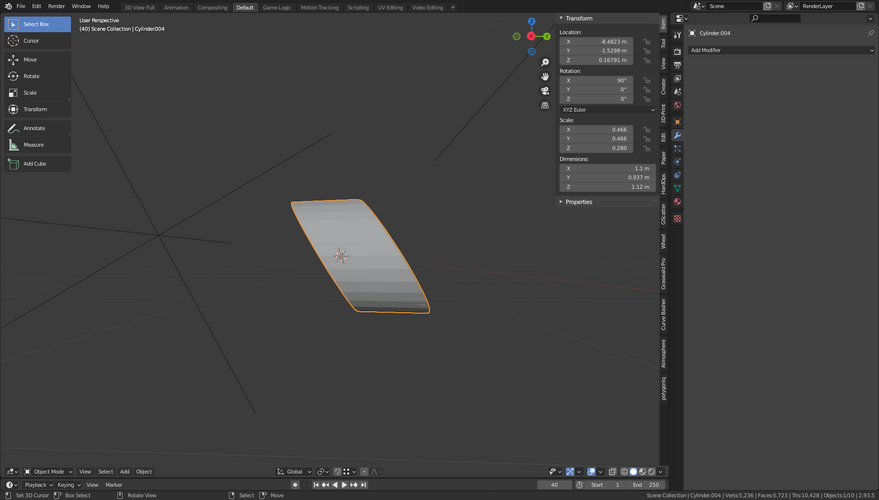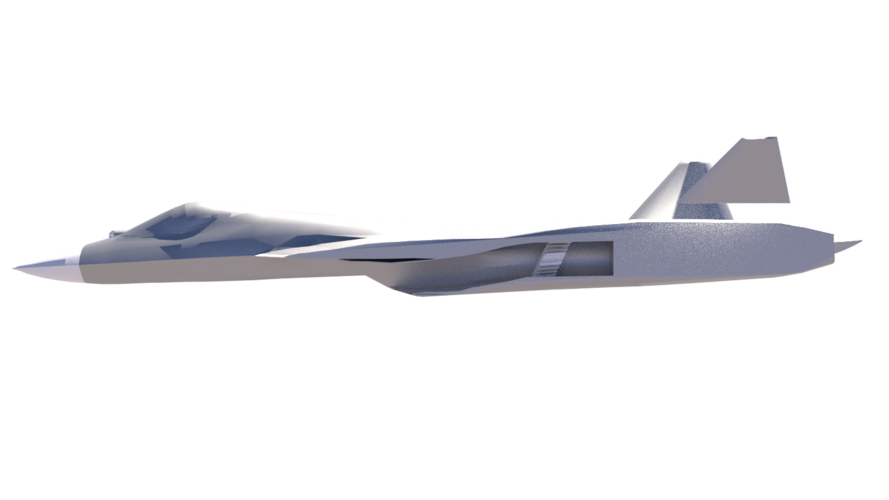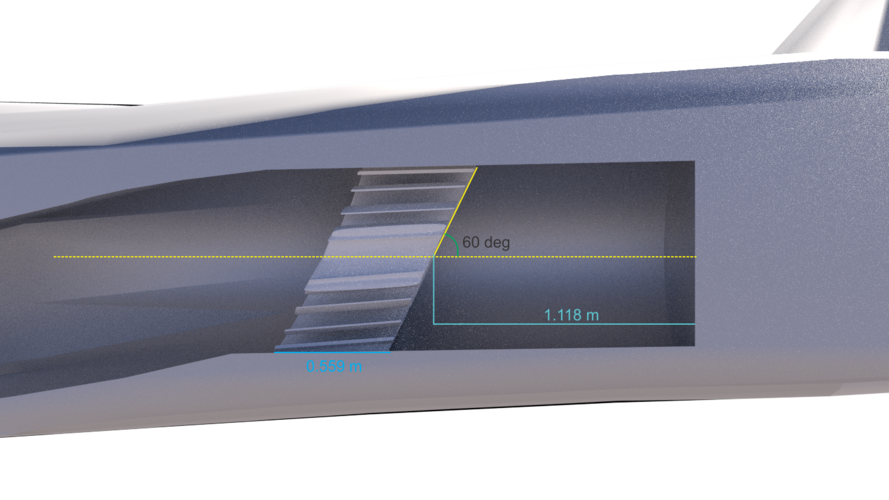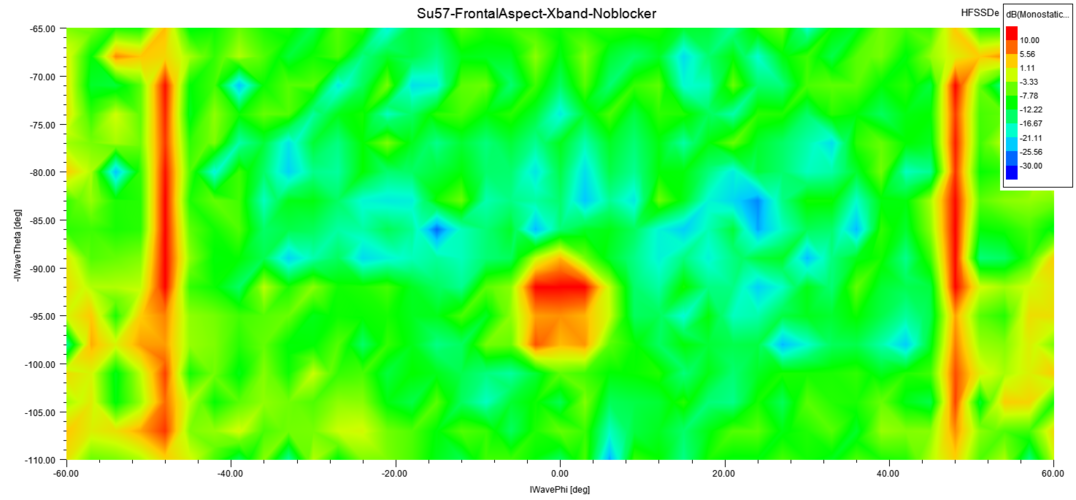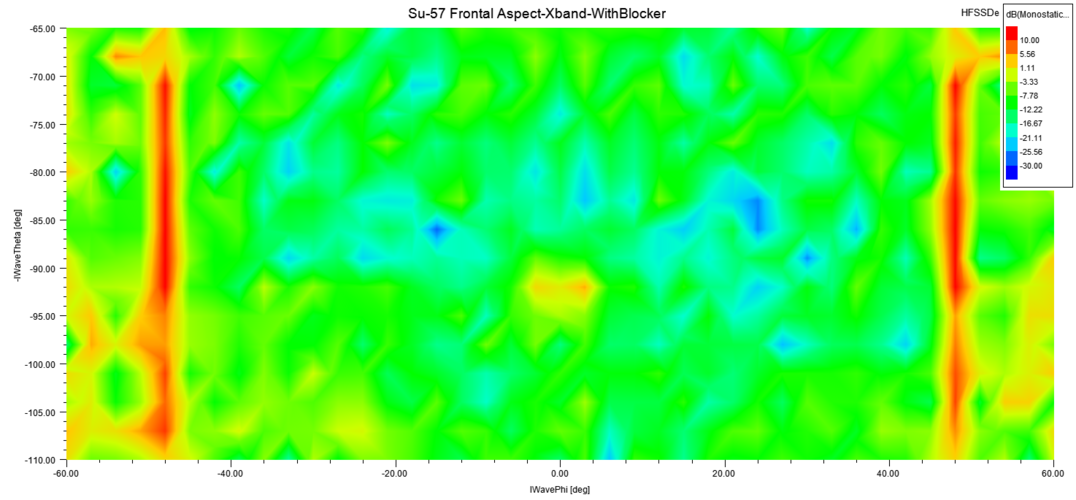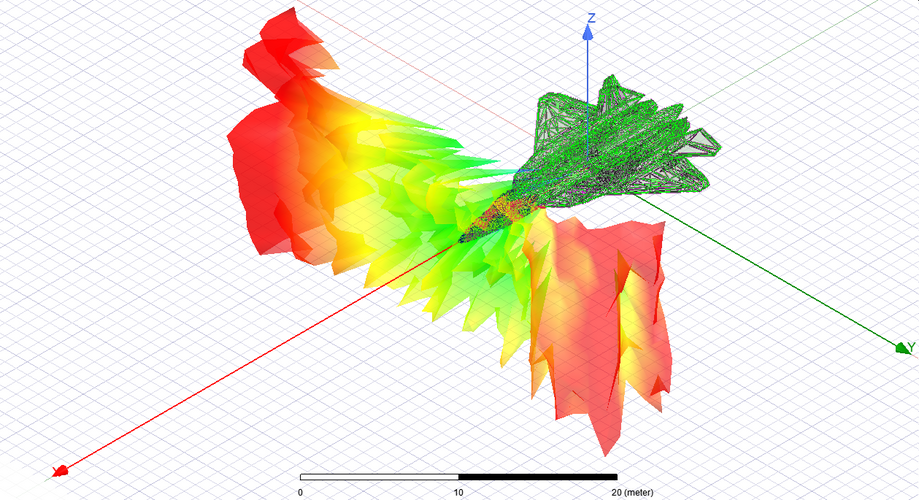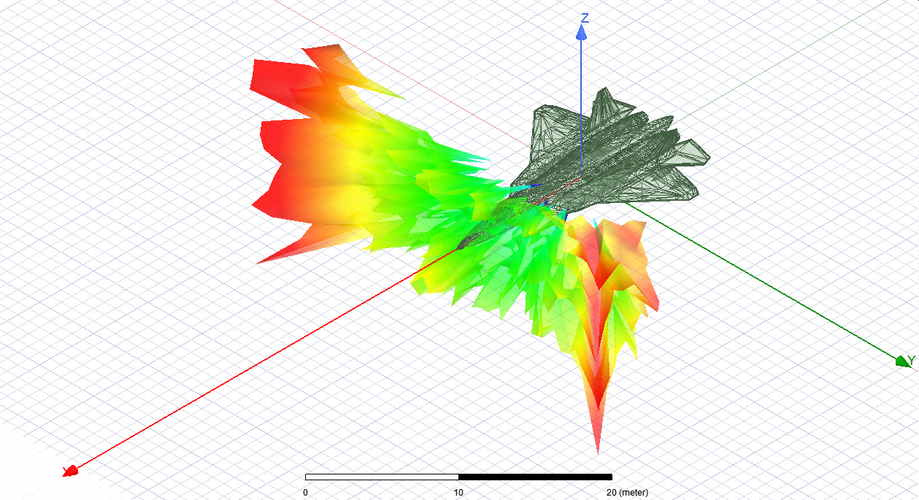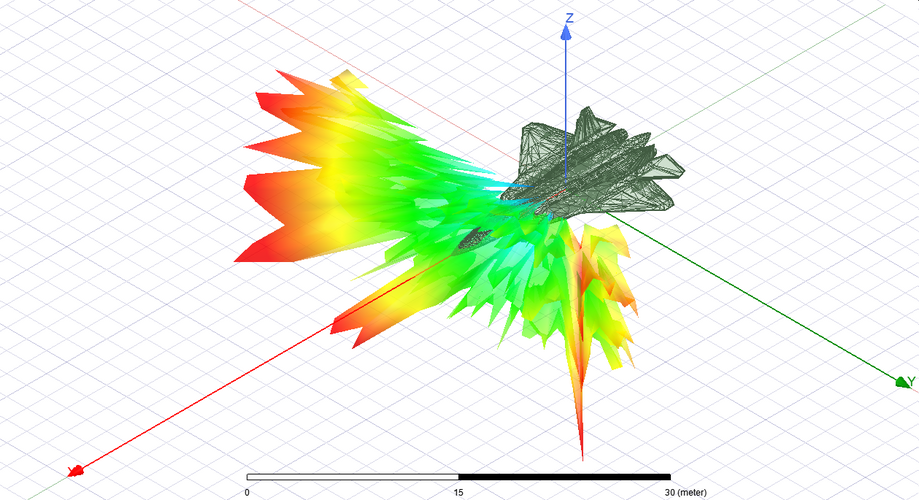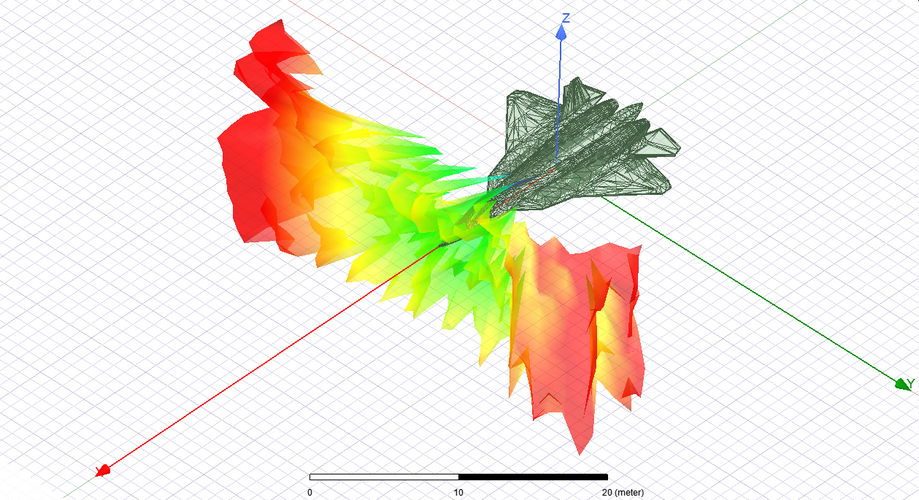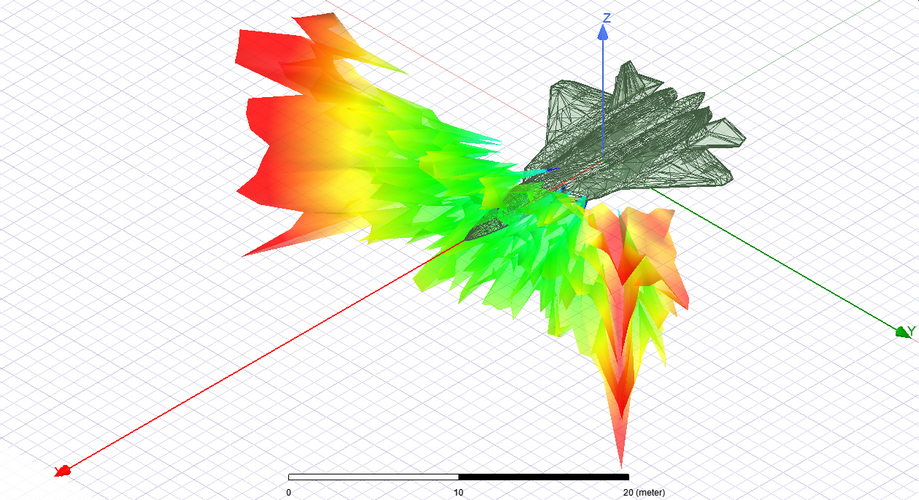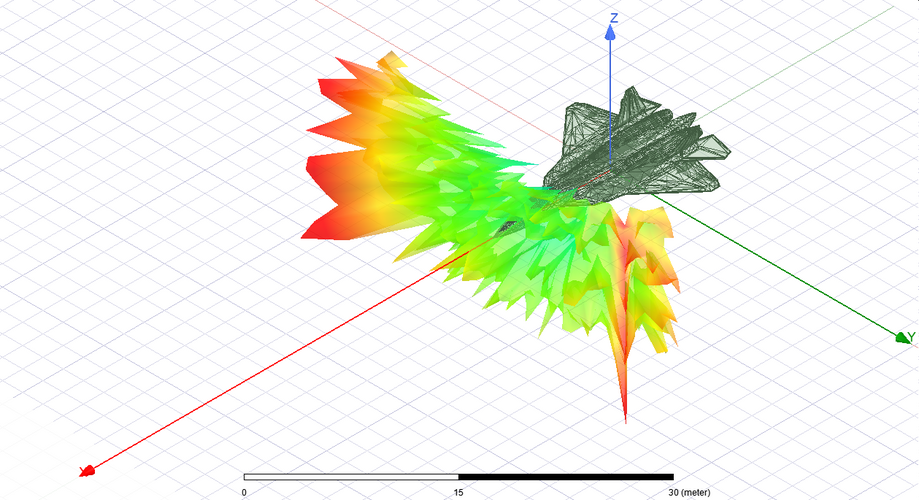You are using an out of date browser. It may not display this or other websites correctly.
You should upgrade or use an alternative browser.
You should upgrade or use an alternative browser.
Sukhoi Su-57 flight testing, development & operations [2012-current]
- Joined
- 11 February 2007
- Messages
- 2,545
- Reaction score
- 4,332
The things to bear in mind for ASM-135 were that it was launched at altitude - top of a zoom-climb, so had a thinner atmosphere and therefore less friction and heating effects to deal with, and was a non-airbreather.Then that would be nonsense, a scramjet missile won't be faster than a Mach 10 ballistic missile. And I can't imagine anything that can be launched from fighter and can reach that speed. The fastest missile ever launched from a fighter aircraft probably the ASM-135 that reached 25,000 km/h but it can do that only because it an anti satellite missilebut i dont know speeds if popular mechanics source say 4 times faster than kinzhal which puts it as mach 40-48
Realistic speed for air launched tactical size scramjet missile probably in the Mach 6-7
The fundamental question for a faster scramjet is whether you can get the inflow through the engine without it causing problems - which is why scramjets are different to ramjets, but if you're forcing more and more air through the engine as you're going faster, then do the internal aerodynamics of the engine hold up? Wiki suggests, with references to one paper, that the top end for scramjets is going to be in the Mach 12-24 range,
- Joined
- 11 February 2010
- Messages
- 1,646
- Reaction score
- 2,695
So this roughly the same as the Su-27's.Fuel system. Volume 11.68 m3. Fuel weight 11.68 m3 * 775 kg/m3 = 9000 kg
- Joined
- 11 February 2010
- Messages
- 1,646
- Reaction score
- 2,695
I recalled there was an image of PAKFA or concept/3D render of it with Faceted IRST. But i didnt manage to found the image.
I wonder if anyone have the image, and whether it is a serious consideration in the design phase.
That is for my reference, so basically i got myself an Su-57 model for ANSYS, it is working (no error and such). just need refinements and also guidance on "good practice"
------
The "first look" however are as follows, i made twitter post about it already but i guess twitter will gut the resolution of the images.
The "current practice" i use


The result, note that it may change as i got better references or supports.

last but not the least is the fluctuation of RCS of considered aspect against frequency. Included for sake of completeness as considering RCS is a function of frequency, one cannot just say "Hey why this is higher (or lower) than someone else's" One instead should ask which frequency was the measurement is taken.

In respect to IRST is that spherical one give rather weak but broad lobes. I would like to compare it with faceted one. The faceted one i expect to give small but strong spikes which also broaden as frequency are getting lower.
I wonder if anyone have the image, and whether it is a serious consideration in the design phase.
That is for my reference, so basically i got myself an Su-57 model for ANSYS, it is working (no error and such). just need refinements and also guidance on "good practice"
------
The "first look" however are as follows, i made twitter post about it already but i guess twitter will gut the resolution of the images.
The "current practice" i use
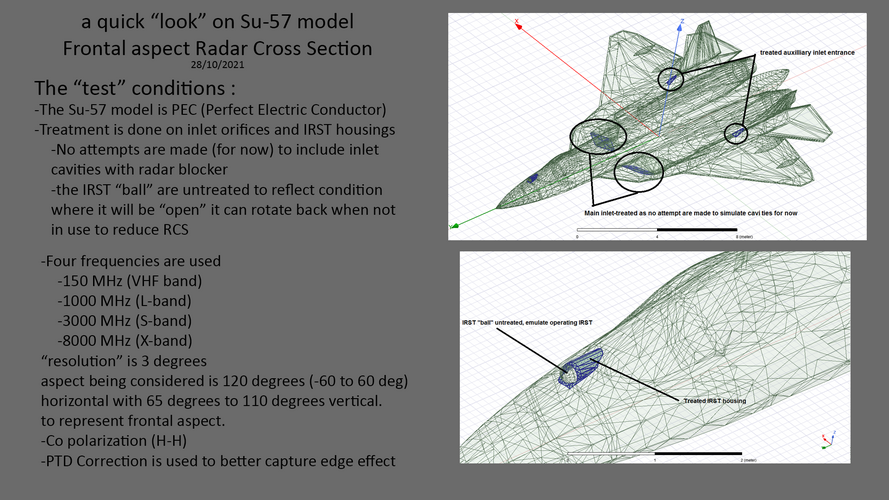
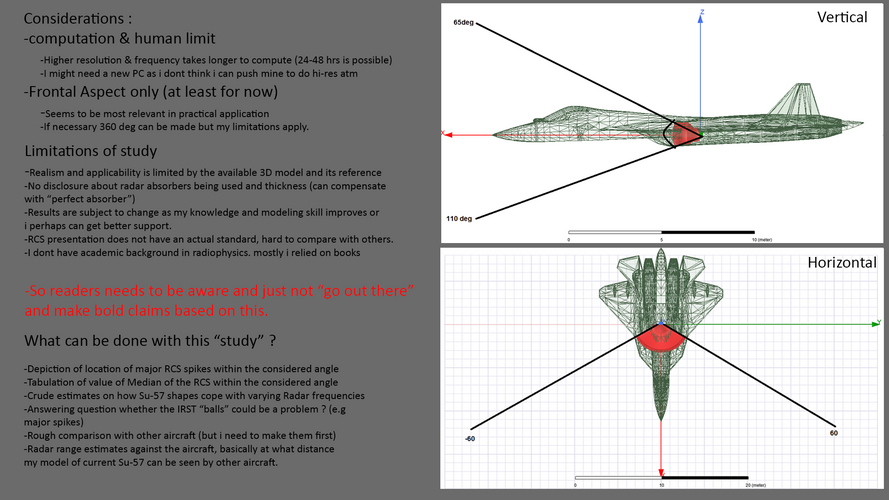
The result, note that it may change as i got better references or supports.
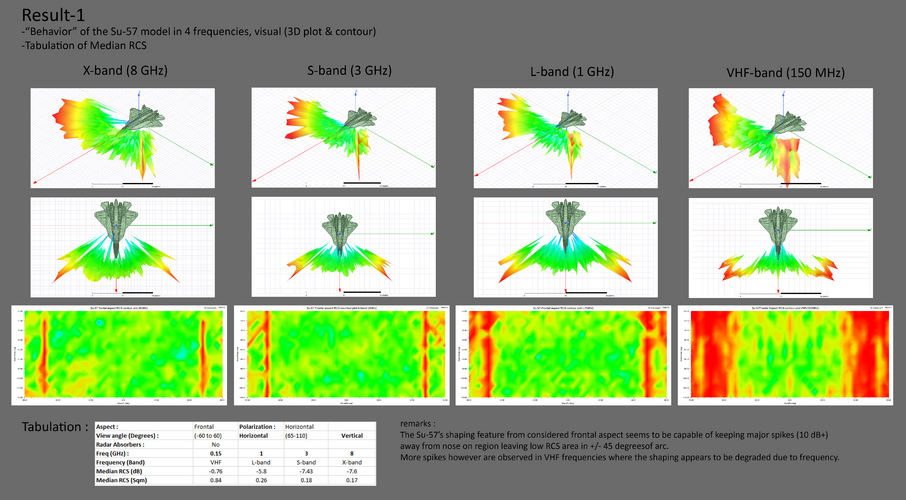
last but not the least is the fluctuation of RCS of considered aspect against frequency. Included for sake of completeness as considering RCS is a function of frequency, one cannot just say "Hey why this is higher (or lower) than someone else's" One instead should ask which frequency was the measurement is taken.
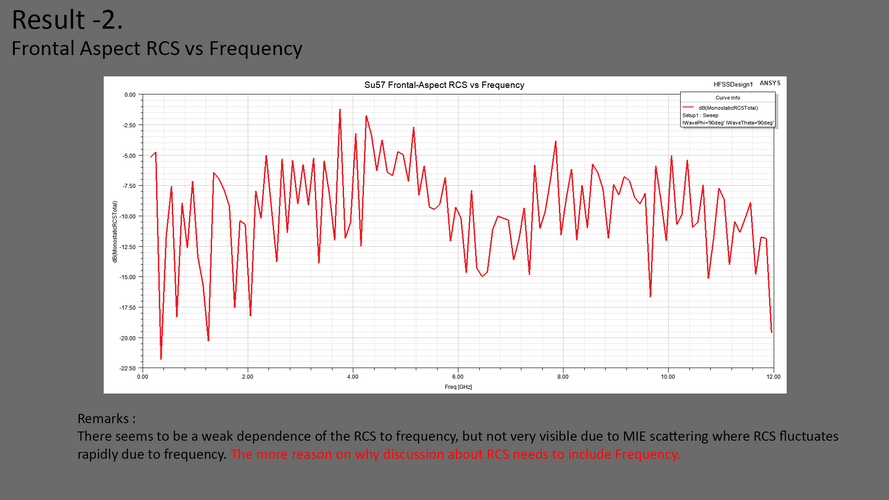
In respect to IRST is that spherical one give rather weak but broad lobes. I would like to compare it with faceted one. The faceted one i expect to give small but strong spikes which also broaden as frequency are getting lower.
LMFS
ACCESS: Top Secret
- Joined
- 19 March 2019
- Messages
- 533
- Reaction score
- 880
Are you considering the IRST ball reflective?In respect to IRST is that spherical one give rather weak but broad lobes. I would like to compare it with faceted one. The faceted one i expect to give small but strong spikes which also broaden as frequency are getting lower.
- Joined
- 11 February 2010
- Messages
- 1,646
- Reaction score
- 2,695
Are you considering the IRST ball reflective?
Yes. Since transparent RAM has yet to be invented, the other way to prevent EM wave from entering and create multiple reflections is to actually make the surface conductive. Thus why we have gold film coating.
You then can attempt to control where the reflection goes with shape, which appears to be the logic of the faceted IRST on JSF. The question is then how big the lobe would be and whether it will present problem.
As you see in my result the IRST "lobes" for the model is kind of unique that the lobe is prominent at 8 GHz and become less so in lower frequencies, and in that band it appears to "dump" majority of it in downward direction.
I also do one which the IRST ball is treated to emulate it being rotated. The first row is the 3D model, 2nd one is the 3D contour plot for the RCS, and 3rd row depicts the surface "map"/contour of the 2nd row.
You can see the Lobe disappear.
Feel free to suggest on improvements.
Last edited:
- Joined
- 11 February 2010
- Messages
- 1,646
- Reaction score
- 2,695
Yes. That's the one. Thanks.I recalled there was an image of PAKFA or concept/3D render of it with Faceted IRST. But i didnt manage to found the image.
I wonder if anyone have the image, and whether it is a serious consideration in the design phase.
This one?
View attachment 666978
- Joined
- 3 June 2011
- Messages
- 18,328
- Reaction score
- 12,196
The things to bear in mind for ASM-135 were that it was launched at altitude - top of a zoom-climb,Then that would be nonsense, a scramjet missile won't be faster than a Mach 10 ballistic missile. And I can't imagine anything that can be launched from fighter and can reach that speed. The fastest missile ever launched from a fighter aircraft probably the ASM-135 that reached 25,000 km/h but it can do that only because it an anti satellite missilebut i dont know speeds if popular mechanics source say 4 times faster than kinzhal which puts it as mach 40-48
Realistic speed for air launched tactical size scramjet missile probably in the Mach 6-7
It was launched at about 36,000 feet.
tequilashooter
ACCESS: Top Secret
- Joined
- 1 January 2021
- Messages
- 699
- Reaction score
- 895
dont want to kill the mood but did the same type of users already go over the same IRST RCS issue specifically at a Su-57 RCS thread before?
LMFS
ACCESS: Top Secret
- Joined
- 19 March 2019
- Messages
- 533
- Reaction score
- 880
@stealthflanker
I don't have that many constructive details, but there is potentially another option which is that the glazing is transparent and the IRST mirror too, with the internal of that cavity and the back being treated with RAM.
I don't have that many constructive details, but there is potentially another option which is that the glazing is transparent and the IRST mirror too, with the internal of that cavity and the back being treated with RAM.
QuadroFX
Russia, Chelyabinsk
Attachments
-
 выпуск истребителей пятого поколения Су-57 на КнААЗ поставлен на поток.mp4_snapshot_00.12.631...png4 MB · Views: 122
выпуск истребителей пятого поколения Су-57 на КнААЗ поставлен на поток.mp4_snapshot_00.12.631...png4 MB · Views: 122 -
 выпуск истребителей пятого поколения Су-57 на КнААЗ поставлен на поток.mp4_snapshot_00.18.305...png3.3 MB · Views: 118
выпуск истребителей пятого поколения Су-57 на КнААЗ поставлен на поток.mp4_snapshot_00.18.305...png3.3 MB · Views: 118 -
 выпуск истребителей пятого поколения Су-57 на КнААЗ поставлен на поток.mp4_snapshot_00.21.543...png4 MB · Views: 119
выпуск истребителей пятого поколения Су-57 на КнААЗ поставлен на поток.mp4_snapshot_00.21.543...png4 MB · Views: 119 -
 выпуск истребителей пятого поколения Су-57 на КнААЗ поставлен на поток.mp4_snapshot_00.50.795...png3.7 MB · Views: 125
выпуск истребителей пятого поколения Су-57 на КнААЗ поставлен на поток.mp4_snapshot_00.50.795...png3.7 MB · Views: 125 -
 выпуск истребителей пятого поколения Су-57 на КнААЗ поставлен на поток.mp4_snapshot_00.51.693...png3.7 MB · Views: 122
выпуск истребителей пятого поколения Су-57 на КнААЗ поставлен на поток.mp4_snapshot_00.51.693...png3.7 MB · Views: 122 -
 выпуск истребителей пятого поколения Су-57 на КнААЗ поставлен на поток.mp4_snapshot_00.53.838...png3.9 MB · Views: 130
выпуск истребителей пятого поколения Су-57 на КнААЗ поставлен на поток.mp4_snapshot_00.53.838...png3.9 MB · Views: 130 -
 выпуск истребителей пятого поколения Су-57 на КнААЗ поставлен на поток.mp4_snapshot_00.53.960...png3.3 MB · Views: 124
выпуск истребителей пятого поколения Су-57 на КнААЗ поставлен на поток.mp4_snapshot_00.53.960...png3.3 MB · Views: 124 -
 выпуск истребителей пятого поколения Су-57 на КнААЗ поставлен на поток.mp4_snapshot_00.57.178...png4.4 MB · Views: 121
выпуск истребителей пятого поколения Су-57 на КнААЗ поставлен на поток.mp4_snapshot_00.57.178...png4.4 MB · Views: 121 -
 выпуск истребителей пятого поколения Су-57 на КнААЗ поставлен на поток.mp4_snapshot_00.58.408...png4.6 MB · Views: 160
выпуск истребителей пятого поколения Су-57 на КнААЗ поставлен на поток.mp4_snapshot_00.58.408...png4.6 MB · Views: 160
- Joined
- 11 February 2010
- Messages
- 1,646
- Reaction score
- 2,695
Well nice, things are picking pace.
tequilashooter
ACCESS: Top Secret
- Joined
- 1 January 2021
- Messages
- 699
- Reaction score
- 895

ВКС получат в декабре четыре истребителя Су-57, сообщил источник
В Воздушно-космические силы (ВКС) скоро поступят новые серийные истребители пятого поколения, сообщил РИА Новости источник в оборонно-промышленном комплексе. РИА Новости, 12.11.2021
MOSCOW, Nov. 12 — RIA Novosti. In aerospace forces (HQS) will soon receive new serial fighters of the fifth generation, told RIA Novosti a source in the military-industrial complex.
"In December, four serial Su-57 fighters should be transferred to the Russian Aerospace Forces from the Komsomolsk-on-Amur Aviation Plant," he said.
Now in the State Flight Test Center named after V. P. Chkalov continues testing the first serial Su-57, which the army received last November. With the delivery of the new batch, the number of such aircraft in the Armed Forces will reach five.
The Su-57 is a fifth-generation Russian multi-role fighter developed by Sukhoi. The machine is designed to destroy all types of air, ground and surface targets. It has a supersonic cruising speed, intrafuselage armament, radio-absorbing coating, as well as the latest complex of on-board equipment.
By the end of 2024, the VKS should receive 22 Su-57s, by 2028 their number in the troops is planned to be increased to 76.
- Joined
- 11 February 2010
- Messages
- 1,646
- Reaction score
- 2,695
So yeah, previously i shared my estimates on Su-57's frontal aspect RCS and then further elaborate on the IRST. During that time for a comparison i made myself an F-35A model and comparing it with the Su-57 one. Same methods and constraints. The F-35A one is explored here :
But well why stop there i wonder. The next initiative would be to include the air duct and thus for Su-57 modeling the radar blocker is a necessity. The blocker itself is based on available photographs and the following patent :
https://www1.fips.ru/fips_servl/fips_servlet?DB=RUPAT&DocNumber=2623031&TypeFile=pdf
A spreadsheet is then made to determine the properties of the blocker and respective relevant dimensions

The blocker model :
In this case i assume the compressor diameter would be 932mm Thus resulted in selected dimensions, 60 degrees is later chosen for the angle of the blocker. I have bit of difficulty understanding the num 5 in the figure whether it is another blocker OR it is a section where inlet duct meet the "mouth" of the engine.
another difficulty is regarding the edge of the blocker which the patent doesnt give any explanation. Edge is important as it is a source of diffraction scattering. There is however treatment which to make the edge blunt (i will dig in the paper where i found that).
Another thing is whether i should add the inlet guidevane and the compressor face and how i should treat them, like leaving them as PEC or apply some form of absorbers. The simplest way is i think to leave it flat to "simulate" a worst case where the engine is not treated.
The calculations then used in the positioning of the blocker within the 3D model, depicted below :
Granted the layout could use refinement which is why i am posting it, maybe it should be "less S" than depicted or maybe it can use bigger duct inside instead of the assumed 932mm the same as the compressor face diameter.
The F-35A model will also undergo similar refinements like fixing some stuff and actually add the S-duct.
anyway feedback are welcome.
The only feedback so far is from one Chinese poster on twitter which curiously have "special" attention to my Su-57 result. Unfortunately his attitude leave lot to be desired particularly in two critical areas :
1.Appeal to authority, wanting realism is good but one should know the boundary
2.Complete negligience to the fact that RCS value is only useful when at least Frequency is given, he wants me to believe the 0.5 sqm RCS value cited in Su-57 patent but unable to provide the frequency. This is fatal as it's been demonstrated and common sense, RCS is a function of frequency too.
Those attitude is unfortunately was not the first time. The other one was in facebook post.
Such attitudes does not promote productive technical discussion at all.
The F-35Amodel result is depicted here :
View: https://twitter.com/Flankerchan/status/1456991340256841732
The result is as follows for the comparison. I planned it for a separate tweet but i guess given the new initiative i would do soon... This would do.
Contour plot & table :

Frontal aspect RCS comparison vs Frequency :

View: https://twitter.com/Flankerchan/status/1456991340256841732
The result is as follows for the comparison. I planned it for a separate tweet but i guess given the new initiative i would do soon... This would do.
Contour plot & table :
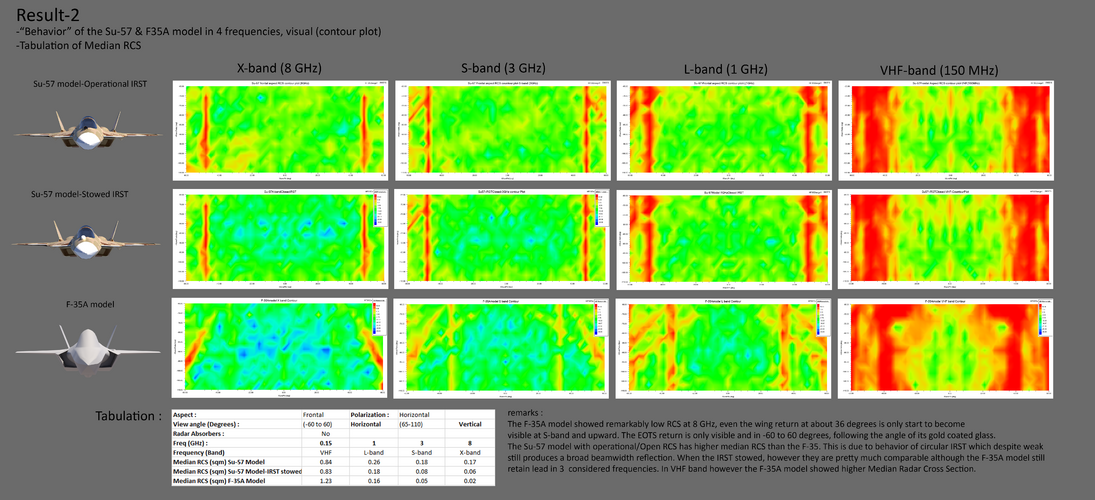
Frontal aspect RCS comparison vs Frequency :
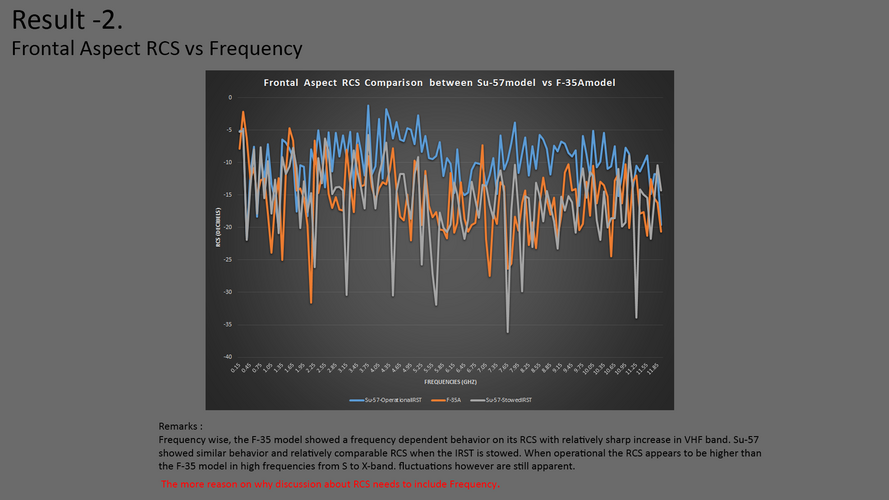
But well why stop there i wonder. The next initiative would be to include the air duct and thus for Su-57 modeling the radar blocker is a necessity. The blocker itself is based on available photographs and the following patent :
https://www1.fips.ru/fips_servl/fips_servlet?DB=RUPAT&DocNumber=2623031&TypeFile=pdf
A spreadsheet is then made to determine the properties of the blocker and respective relevant dimensions
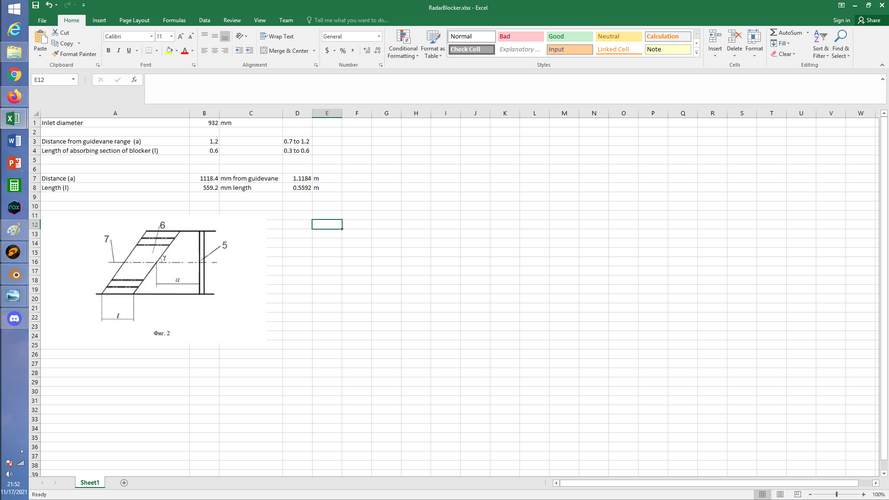
The blocker model :
In this case i assume the compressor diameter would be 932mm Thus resulted in selected dimensions, 60 degrees is later chosen for the angle of the blocker. I have bit of difficulty understanding the num 5 in the figure whether it is another blocker OR it is a section where inlet duct meet the "mouth" of the engine.
another difficulty is regarding the edge of the blocker which the patent doesnt give any explanation. Edge is important as it is a source of diffraction scattering. There is however treatment which to make the edge blunt (i will dig in the paper where i found that).
Another thing is whether i should add the inlet guidevane and the compressor face and how i should treat them, like leaving them as PEC or apply some form of absorbers. The simplest way is i think to leave it flat to "simulate" a worst case where the engine is not treated.
The calculations then used in the positioning of the blocker within the 3D model, depicted below :
Granted the layout could use refinement which is why i am posting it, maybe it should be "less S" than depicted or maybe it can use bigger duct inside instead of the assumed 932mm the same as the compressor face diameter.
The F-35A model will also undergo similar refinements like fixing some stuff and actually add the S-duct.
anyway feedback are welcome.
The only feedback so far is from one Chinese poster on twitter which curiously have "special" attention to my Su-57 result. Unfortunately his attitude leave lot to be desired particularly in two critical areas :
1.Appeal to authority, wanting realism is good but one should know the boundary
2.Complete negligience to the fact that RCS value is only useful when at least Frequency is given, he wants me to believe the 0.5 sqm RCS value cited in Su-57 patent but unable to provide the frequency. This is fatal as it's been demonstrated and common sense, RCS is a function of frequency too.
Those attitude is unfortunately was not the first time. The other one was in facebook post.
Such attitudes does not promote productive technical discussion at all.
- Joined
- 11 February 2010
- Messages
- 1,646
- Reaction score
- 2,695
Will you model S-75 too?
yes, eventually. i'm currently have Su-57, JSF F-35A, KF-21, a very crude model of J-20 and an F-22 in WIP.
Cannonfodder43
ACCESS: Confidential
- Joined
- 8 December 2019
- Messages
- 115
- Reaction score
- 303
http://www.su57.mariwoj.pl/su57-index.html An image from a very good site which also has other good imagery, saw one of its type here but have not seen this one on any of the Su-57 threads.

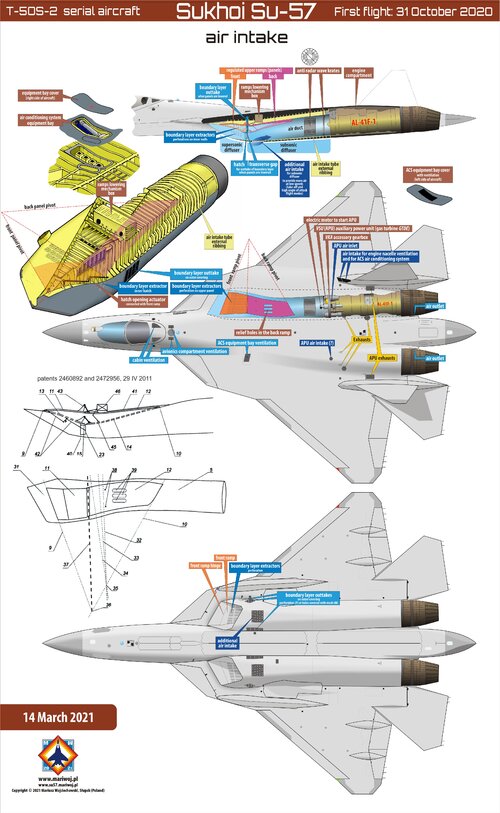
tequilashooter
ACCESS: Top Secret
- Joined
- 1 January 2021
- Messages
- 699
- Reaction score
- 895
Новую ракету для Су-57 оценили в Китае
Гиперзвуковая ракета "Личинка-МД" оснащена новым двигателем, разгоняющим ее до пяти Махов. Ракета разработана специально для Су-57 и размещается в его внутренних отсеках, не ухудшая малозаметности
The Magika-MD hypersonic missile, which is planned to equip the fifth-generation Su-57 aircraft, will play a big role in increasing the combat power of the Russian Aerospace Forces, said Wang Yongqing, chief designer of the Shenyang Aviation Industry Institute. His article on the promising armament of the fighter was published by The Paper, the translation of the material leads InoSMI.
The new weapon for the Russian aircraft is still under development, flight tests have not yet been conducted and the characteristics of the "Larva" (this is the name of the experimental design work) have not been disclosed. Nevertheless, two key features of the missile are known. First, this is the first experience of developing weapons specifically for the Su-57 - the "Larva-MD" will be placed in the internal compartments of the aircraft and, thus, will not affect its stealth. Second, the rocket's new jet engine will allow it to reach a speed of Mach five, which will more than halve the time it will strike large surface ships.
The combination of a stealth aircraft with hypersonic missiles will significantly increase the strike power of the Su-57 and allow it to move closer to the target at a minimum distance.
- Russia pays great attention to reducing the effectiveness of the enemy's combat systems and defeating its key positions. Ultra-long-range air-to-air missiles are being created to destroy flying radars and tanker aircraft. For air battles, new long-, medium- and short-range missiles have been developed. At the same time, air-to-air and air-to-surface ammunition is developed in parallel, without shifting the emphasis to any of them. And the large combat load of the new aircraft allows us to equip them with missiles both for fighting in the air and for striking at the surface," Wang Yongqing said.
Last edited by a moderator:
Also some progress on reducing time to applying special coating. If i understand it well, 50% time reduction on all moving tail and wingtip.
If you all interested, i upload the pdf files. The previous post pict with alot of students is from #9 edition. The guy with microsoft hololens is from the #12 edition. The special coating report from #10 edition.
If you all interested, i upload the pdf files. The previous post pict with alot of students is from #9 edition. The guy with microsoft hololens is from the #12 edition. The special coating report from #10 edition.
Attachments
- Joined
- 11 February 2010
- Messages
- 1,646
- Reaction score
- 2,695
Well, the simulation for Su-57 by taking account of its radar blocker are done. The result so far looks cool. This one here shows X-band (8 GHz) With IRST rotated backward for "maximum stealth". The inlet wall are treated along with the radar blocker.
The same image but as contour plot :
As seen. the strong return from the inlet are successfully reduced by the application of radar blocker. However it is still there, although may not be as menacing as it was.
For the modeling strategy. in place of engine i use a "substitute body" Which basically a "front end" of engine. this is done as EM wave apparently does not got in too far, according to P.Tait's "introduction to radar target recognition".
The following depicts the substitution body and the blocker :

The position of them within the inlet :

The reference :

thus following layout is made :

As seen the blocker and substitution body are in place. Considering that ANSYS doesnt do well with open ended geometry The inlet is made as solid block, where the "open part" is defined via "boundary assignment" feature. As depicted above there are 2 "air gaps" boundary. These boundary are made out of air thus defined the "open" part of the inlet.
The inlet and its respective wall are then "treated" with Absorbers :

One part of the absorber are "out of place" due to geometrical problem. The part of inlet where the engine substitution body resides and its respective fan stages are left as PEC or perfect metal, based on assumption that these parts are not treated, which is difficult due to physical stress from rotating parts. The "rear" wall of the inlet are treated as air gap to simulate the rear end where the EM wave may be lost.
Further simulations on other frequencies shows the "spikes" are disappearing in lower frequency. this also lent credence to the reference above that Fighter aircraft inlet are rather "too small" and long for a proper propagation of lower frequency wavelength. Below is depicted the result of the simulation of Su-57 inlet without radar blocker in 4 frequencies (0.15 GHz, 1 GHz, 3 GHz, 8 GHz). Which makes me conclude that the blocker and probably the respective inlet coatings are optimized for high frequencies.
Without radar blocker
With radar blocker equipped
One may notice that the RCS for lower band are not much different for lower frequencies. The spikes from the engine blades are starting to visible at 3 GHz and become stronger in higher frequency.
numerical value wise one might be surprised that not much of a difference between one with radar blocker equipped and another without.

This shows the "weaknesses" of attempting to generalize the RCS value either by Median average or just average. Which not to say the value from there is not useful (One may need to run additional statistical analysis. e.g Kolmogorov-Smirnoff test to see the distribution of the RCS value whether it is normal or not) But without proper visualization e.g 3D or maybe plot, one can miss one or more strong lobes within the aircraft which warrant supression.
As for the problem of the simulation is that it's remain very speculative as i have no real idea about the material or whether the blocker design i use is really what it used in Su-57. It may have similar front looks but the angles and how long the absorbing section is remains unknown to me.
hmm anyway what do you guys think ?
| Withour Radar Blocker. | With Radar Blocker |
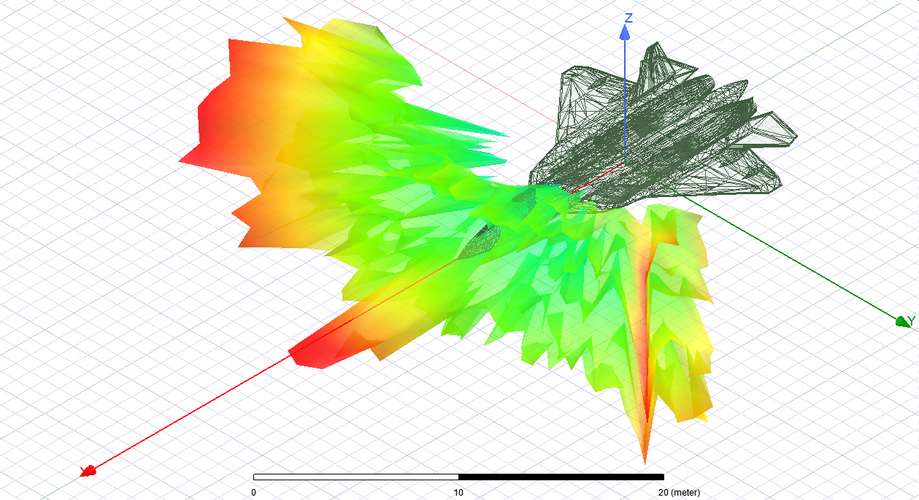
|
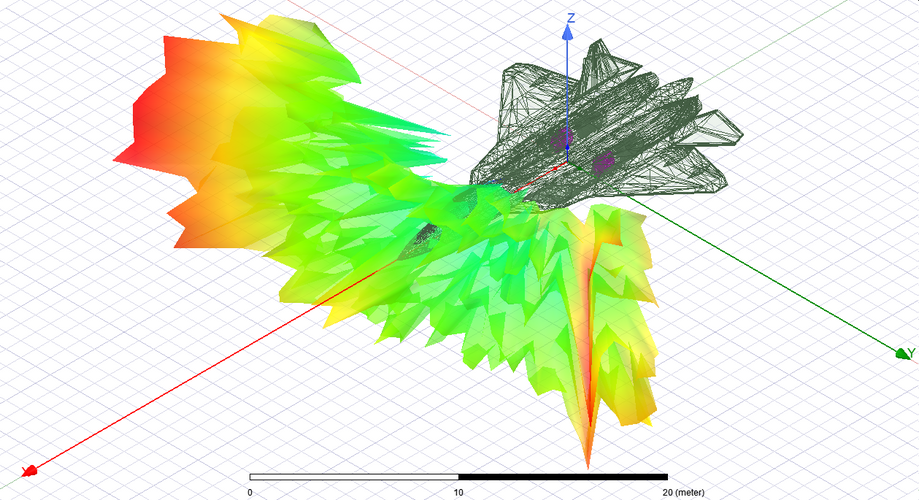
|
| Remarks : strong return from the Engine | Remarks : The return are still there but greatly supressed by the radar blocker |
The same image but as contour plot :
As seen. the strong return from the inlet are successfully reduced by the application of radar blocker. However it is still there, although may not be as menacing as it was.
For the modeling strategy. in place of engine i use a "substitute body" Which basically a "front end" of engine. this is done as EM wave apparently does not got in too far, according to P.Tait's "introduction to radar target recognition".
The following depicts the substitution body and the blocker :
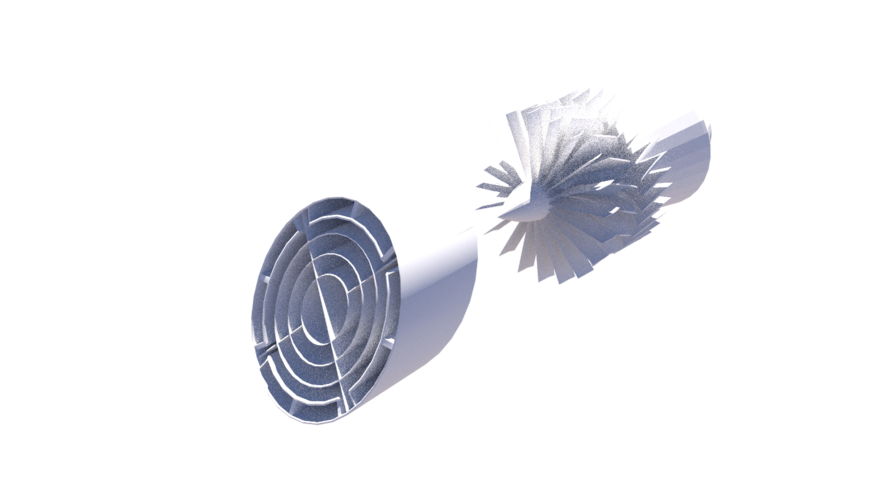
The position of them within the inlet :
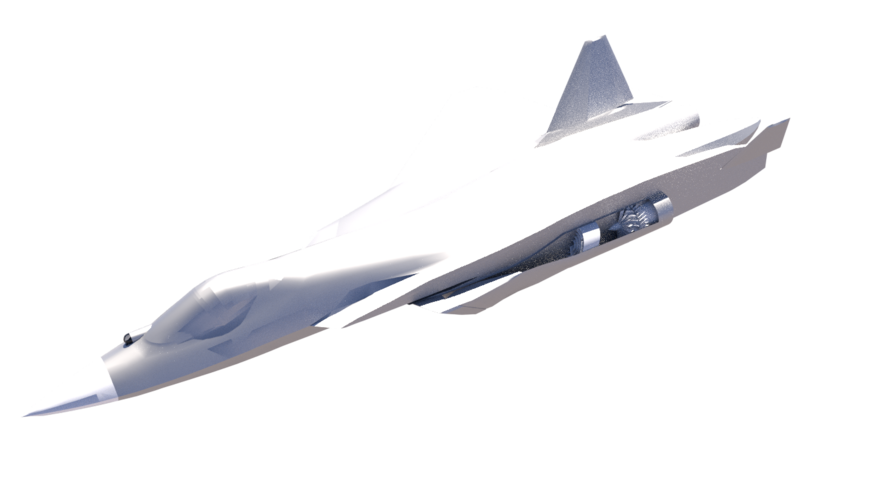
The reference :
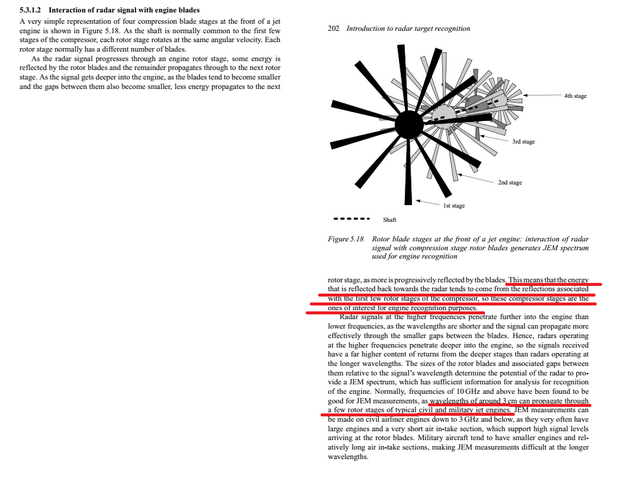
thus following layout is made :
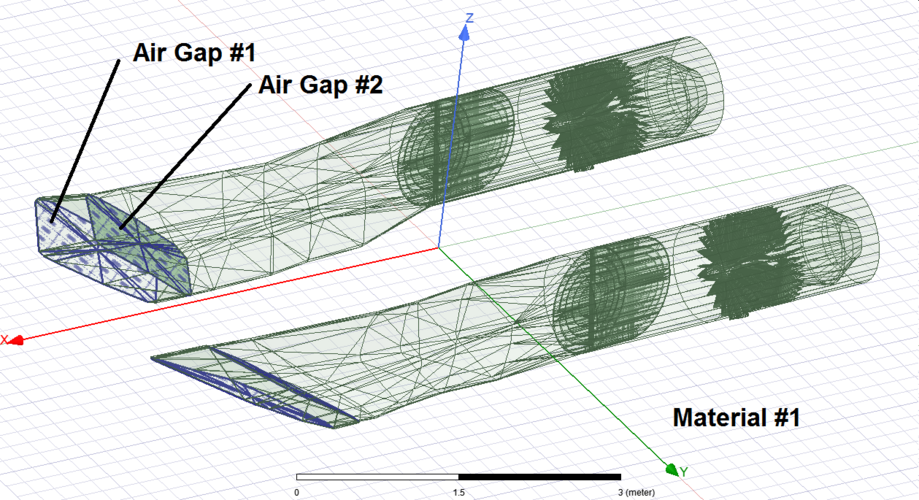
As seen the blocker and substitution body are in place. Considering that ANSYS doesnt do well with open ended geometry The inlet is made as solid block, where the "open part" is defined via "boundary assignment" feature. As depicted above there are 2 "air gaps" boundary. These boundary are made out of air thus defined the "open" part of the inlet.
The inlet and its respective wall are then "treated" with Absorbers :
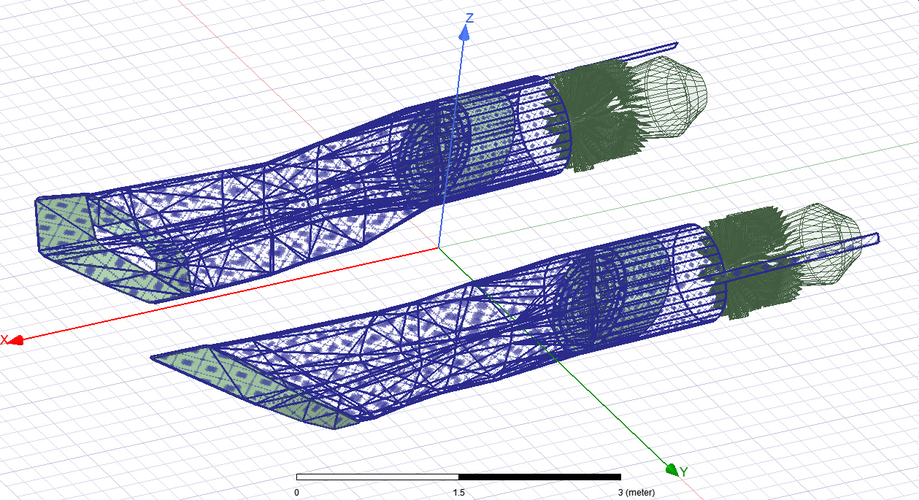
One part of the absorber are "out of place" due to geometrical problem. The part of inlet where the engine substitution body resides and its respective fan stages are left as PEC or perfect metal, based on assumption that these parts are not treated, which is difficult due to physical stress from rotating parts. The "rear" wall of the inlet are treated as air gap to simulate the rear end where the EM wave may be lost.
Further simulations on other frequencies shows the "spikes" are disappearing in lower frequency. this also lent credence to the reference above that Fighter aircraft inlet are rather "too small" and long for a proper propagation of lower frequency wavelength. Below is depicted the result of the simulation of Su-57 inlet without radar blocker in 4 frequencies (0.15 GHz, 1 GHz, 3 GHz, 8 GHz). Which makes me conclude that the blocker and probably the respective inlet coatings are optimized for high frequencies.
Without radar blocker
With radar blocker equipped
One may notice that the RCS for lower band are not much different for lower frequencies. The spikes from the engine blades are starting to visible at 3 GHz and become stronger in higher frequency.
numerical value wise one might be surprised that not much of a difference between one with radar blocker equipped and another without.

This shows the "weaknesses" of attempting to generalize the RCS value either by Median average or just average. Which not to say the value from there is not useful (One may need to run additional statistical analysis. e.g Kolmogorov-Smirnoff test to see the distribution of the RCS value whether it is normal or not) But without proper visualization e.g 3D or maybe plot, one can miss one or more strong lobes within the aircraft which warrant supression.
As for the problem of the simulation is that it's remain very speculative as i have no real idea about the material or whether the blocker design i use is really what it used in Su-57. It may have similar front looks but the angles and how long the absorbing section is remains unknown to me.
hmm anyway what do you guys think ?
I think the original will have the same result as with the S-shaped channel.hmm anyway what do you guys think ?
LMFS
ACCESS: Top Secret
- Joined
- 19 March 2019
- Messages
- 533
- Reaction score
- 880
@stealthflanker
I think you may consider modelling the inlet guide vanes of the engine. And maybe play around with them considering that the izd. 30 has been designed for improved stealth, there is probably more than a couple of things properly designed vanes can do to help with RCS.
I think you may consider modelling the inlet guide vanes of the engine. And maybe play around with them considering that the izd. 30 has been designed for improved stealth, there is probably more than a couple of things properly designed vanes can do to help with RCS.
- Joined
- 11 February 2010
- Messages
- 1,646
- Reaction score
- 2,695
@stealthflanker
I think you may consider modelling the inlet guide vanes of the engine. And maybe play around with them considering that the izd. 30 has been designed for improved stealth, there is probably more than a couple of things properly designed vanes can do to help with RCS.
It's there. Except it is assumed to be untreated at the moment.
LMFS
ACCESS: Top Secret
- Joined
- 19 March 2019
- Messages
- 533
- Reaction score
- 880
Now I saw them, sorry. I think you can safely assume they are treated, even those in the newer RD33MK are. Probably you can change the geometry (make the vanes deeper for instance) so they are more selective in the beam entry angle, or even include an S shaped duct on them, but that may have influence in the engine's performance...It's there. Except it is assumed to be untreated at the moment.
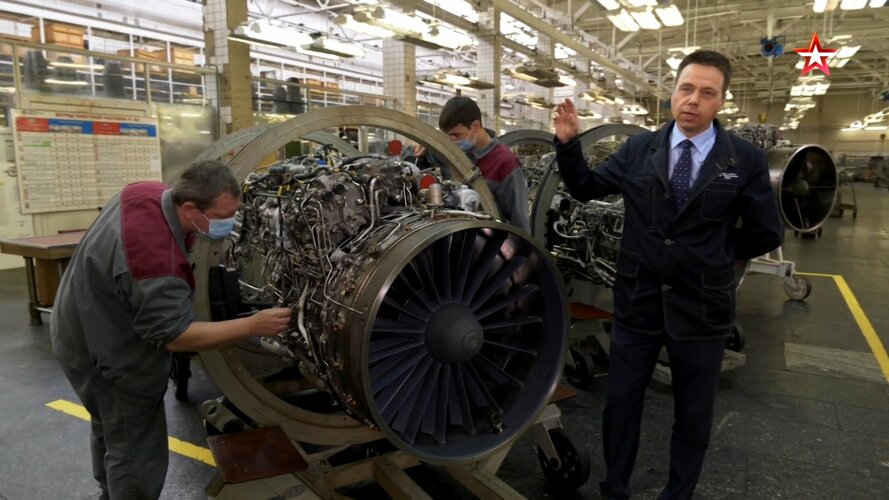
Last edited:
LMFS
ACCESS: Top Secret
- Joined
- 19 March 2019
- Messages
- 533
- Reaction score
- 880
Troops from 2027 will start receiving the Su-57 fighter in a new look-board of the Military-Industrial Complex
09.12.2021 9:19:21
*** A hypersonic missile is already ready for him
Moscow. December 9. INTERFAX-The Su-57 fighter will be equipped with hypersonic weapons, and from 2027 the aircraft will be sent to the troops with a new engine, First Deputy Chairman of the Board of the Military-Industrial Commission (MIC) of Russia Andrey Yelchaninov said in an interview with Interfax.
"Tests of the aircraft with the new engine should be completed by 2024. In general, tests with the completion of the second stage engine will last until 2026, and the delivery of aircraft in a new look is planned as part of the new state armament program from 2027. This will be about 25 cars out of 76 under the already concluded long-term contract, " Yelchaninov said.
According to him, a serious increase in the need of the Russian Defense Ministry for this aviation complex is already visible.
"In the near future, the Su-57 will be able to use hypersonic weapons, the missile is already ready, " Yelchaninov said.
The Su-57 is a fifth-generation multirole fighter designed to destroy all types of air targets in long-range and close combat, defeat enemy ground and surface targets while overcoming air defense systems. Its first flight took place on January 29, 2010.
At the end of 2020, the first serial Su-57 was accepted into the Russian Aerospace Forces. By the end of 2024, the Russian military plans to receive another 22 such aircraft. In total, by 2028, 76 fifth-generation fighters should be produced, which will complement three air regiments.
Earlier it was reported that the first Su-57s will be produced in serial form, but with engines of the previous generation. The engine of the "second stage" (product 30 produced by UEC), which will provide the Su-57 with supersonic cruising speed, began flight tests in December 2017.
https://www.militarynews.ru/story.asp?rid=1&nid=561996&lang=RU
I was expecting izd. 30 to go to the series starting in 2025, but it seems only ca. 25 units of the current order will be supplied with it, that would be the roughly two squadrons to be produced in 2027 and 2028. That is still some years in the future so we will see.
09.12.2021 9:19:21
*** A hypersonic missile is already ready for him
Moscow. December 9. INTERFAX-The Su-57 fighter will be equipped with hypersonic weapons, and from 2027 the aircraft will be sent to the troops with a new engine, First Deputy Chairman of the Board of the Military-Industrial Commission (MIC) of Russia Andrey Yelchaninov said in an interview with Interfax.
"Tests of the aircraft with the new engine should be completed by 2024. In general, tests with the completion of the second stage engine will last until 2026, and the delivery of aircraft in a new look is planned as part of the new state armament program from 2027. This will be about 25 cars out of 76 under the already concluded long-term contract, " Yelchaninov said.
According to him, a serious increase in the need of the Russian Defense Ministry for this aviation complex is already visible.
"In the near future, the Su-57 will be able to use hypersonic weapons, the missile is already ready, " Yelchaninov said.
The Su-57 is a fifth-generation multirole fighter designed to destroy all types of air targets in long-range and close combat, defeat enemy ground and surface targets while overcoming air defense systems. Its first flight took place on January 29, 2010.
At the end of 2020, the first serial Su-57 was accepted into the Russian Aerospace Forces. By the end of 2024, the Russian military plans to receive another 22 such aircraft. In total, by 2028, 76 fifth-generation fighters should be produced, which will complement three air regiments.
Earlier it was reported that the first Su-57s will be produced in serial form, but with engines of the previous generation. The engine of the "second stage" (product 30 produced by UEC), which will provide the Su-57 with supersonic cruising speed, began flight tests in December 2017.
https://www.militarynews.ru/story.asp?rid=1&nid=561996&lang=RU
I was expecting izd. 30 to go to the series starting in 2025, but it seems only ca. 25 units of the current order will be supplied with it, that would be the roughly two squadrons to be produced in 2027 and 2028. That is still some years in the future so we will see.
I was expecting izd. 30 to go to the series starting in 2025,
Well, in my opinion, this is still the same problem: Russian senseless and merciless taboid journalism. Illiterate and aggressive. With such journalists, foreign propaganda will soon have nothing to eat. But this is the lyrics.
There, the speech will most likely be like this in reality: 2024 is the final year of tests 30.
2025 is the year of the launch of the aircraft with a new engine into series.
2026 is the year of receipt of the first aircraft with 30 engine.
That actually flashed before.
...and me was expecting it in serial production by 2023-2024.((I was expecting izd. 30 to go to the series starting in 2025
Yeah this is definitely a delay for the "definitive" plane compared to what I expected, but Coronavirus did happen....and me was expecting it in serial production by 2023-2024.((I was expecting izd. 30 to go to the series starting in 2025
I expected there to be a few (dozen) 117 aircraft before production switch, but now it looks like it could be most of the 76 order.
Let's be honest though there might be further shifts before 2027 arrives.
The question this now opens is- how many "Su-57M" or whatever it will be called will be ordered after the 76 contract is over?
I have a feeling it will be a pleasantly high amount.
FighterJock
ACCESS: Above Top Secret
- Joined
- 29 October 2007
- Messages
- 5,596
- Reaction score
- 5,923
Yeah this is definitely a delay for the "definitive" plane compared to what I expected, but Coronavirus did happen....and me was expecting it in serial production by 2023-2024.((I was expecting izd. 30 to go to the series starting in 2025
I expected there to be a few (dozen) 117 aircraft before production switch, but now it looks like it could be most of the 76 order.
Let's be honest though there might be further shifts before 2027 arrives.
The question this now opens is- how many "Su-57M" or whatever it will be called will be ordered after the 76 contract is over?
I have a feeling it will be a pleasantly high amount.
I hope that it is over 100-200 Su-57M TR1, certainly not the 700 airframes that the Su-27 got from the then VVS when the Flanker was first ordered and put into production I am afraid that those days are long gone sadly.
I think over 200 total airframes is the very lowest total (57 and 57M) airframe production will be for VKS, 300 more likely.Yeah this is definitely a delay for the "definitive" plane compared to what I expected, but Coronavirus did happen....and me was expecting it in serial production by 2023-2024.((I was expecting izd. 30 to go to the series starting in 2025
I expected there to be a few (dozen) 117 aircraft before production switch, but now it looks like it could be most of the 76 order.
Let's be honest though there might be further shifts before 2027 arrives.
The question this now opens is- how many "Su-57M" or whatever it will be called will be ordered after the 76 contract is over?
I have a feeling it will be a pleasantly high amount.
I hope that it is over 100-200 Su-57M TR1, certainly not the 700 airframes that the Su-27 got from the then VVS when the Flanker was first ordered and put into production I am afraid that those days are long gone sadly.
Agreed it definitly won't be anything like 400-500 or more planes. But there are UAVs to consider taking up force structure, and a pretty young and large Flanker fleet, and maybe....some Su-75s to fill out the force?
Funny but I don't think the latter will be even close to 57 in fleet numbers, assuming VKS actually buys it in more than token numbers.
LMFS
ACCESS: Top Secret
- Joined
- 19 March 2019
- Messages
- 533
- Reaction score
- 880
It can be worse, I tell you... that is just a two years more than expected, and the actual year of delivery to the air forces had never been mentioned that I can rememberWell, in my opinion, this is still the same problem: Russian senseless and merciless taboid journalism. Illiterate and aggressive. With such journalists, foreign propaganda will soon have nothing to eat. But this is the lyrics.
Since there is a big modernization project going on related to actuators, avionics etc. and then modifications need to be applied to the production line, it is actually not so strange that there are some years needed from the tests mentioned earlier and the actual supply to the VKS.There, the speech will most likely be like this in reality: 2024 is the final year of tests 30.
2025 is the year of the launch of the aircraft with a new engine into series.
2026 is the year of receipt of the first aircraft with 30 engine.
That actually flashed before.
That is just two or three squadrons more that will need retrofit later, nothing critical me thinks... but I would indeed like to have more info about izd. 30 before that...and me was expecting it in serial production by 2023-2024.((
I think your intuition is right, on the one hand VKS seems to be transitioning to three squadron regiments, on the other in the interview they already state:The question this now opens is- how many "Su-57M" or whatever it will be called will be ordered after the 76 contract is over?
I have a feeling it will be a pleasantly high amount.
According to him, a serious increase in the need of the Russian Defense Ministry for this aviation complex is already visible.
Su-57 is the replacement of Su-27, slated to operate for 40-50 years and therefore to end up more or less replacing most of the Flankers, and on top of that, the Megapolis project and arrival of the "definitive" Su-57 design is obviously not done for a couple of squadrons. The production will most likely continue for many years in the future.
I actually think it will be the other way around, because VKS and VMF-MA are growing and doing it with the Su-75 will be way cheaper. If you notice, the LTS is almost a replacement for the Su-30, so Sukhoi has been smart enough not to design the plane as a very light, range and payload limited airframe, but as one that can be used even to replace Flankers to a certain extent. Nevertheless, the 200-300 Su-57 seem a right number to me in the long run, considering that the amount of fighter types in the fleet should be reduced to Su-57 (say 200-250 units) and Su-75 (400-500).Funny but I don't think the latter will be even close to 57 in fleet numbers, assuming VKS actually buys it in more than token numbers.
- Joined
- 11 February 2010
- Messages
- 1,646
- Reaction score
- 2,695
I think you can safely assume they are treated, even those in the newer RD33MK are
Sure thing, let's see how it turn out.
We'll see. 100-200 would be great, replacing those early Su-27's and maybe Su-35 too.The question this now opens is- how many "Su-57M" or whatever it will be called will be ordered after the 76 contract is over?
I have a feeling it will be a pleasantly high amount.
One thing is will "Su-57E" still be a thing ? Considering that there is Checkmate. I sometime got a feeling that Russia will not export the 57's but instead Checkmate.
- Joined
- 9 October 2009
- Messages
- 21,944
- Reaction score
- 13,576
One thing is will "Su-57E" still be a thing ? Considering that there is Checkmate. I sometime got a feeling that Russia will not export the 57's but instead Checkmate.
That could well end up being the case.
Ainen
I really should change my personal text
- Joined
- 25 August 2011
- Messages
- 1,252
- Reaction score
- 1,679
Why not both?I think you can safely assume they are treated, even those in the newer RD33MK are
Sure thing, let's see how it turn out.
We'll see. 100-200 would be great, replacing those early Su-27's and maybe Su-35 too.The question this now opens is- how many "Su-57M" or whatever it will be called will be ordered after the 76 contract is over?
I have a feeling it will be a pleasantly high amount.
One thing is will "Su-57E" still be a thing ? Considering that there is Checkmate. I sometime got a feeling that Russia will not export the 57's but instead Checkmate.
Here is the link for December 2020. You don't need to read the title. Read Chemezov's direct speech immediately....and me was expecting it in serial production by 2023-2024.((
It will take "several years" to go into series production after 2022, he says.
So all this has been said about the timing before. Journalists were simply unable to convey information to the consumer normally. Hence the confusion, as well as about the "Leader", which no one was going to build officially.

Штатный двигатель для Су-57 планируют создать в 2022 году
Работы по созданию двигателя второго этапа для российского истребителя пятого поколения Су-57 завершатся в 2022 году, заявил журналистам гендиректор... РИА Новости, 07.12.2020
Let me remind you that the only, albeit unofficial, figure for the need for fighters for the Aerospace Forces (excluding fleet aviation) was named at one time at 700 units. For twenty, twenty-five years, this figure is quite achievable. I do not understand what the problem is, because apart from KnAAZ, there are two more plants that will have to be loaded with something after the production of the T-10 family is curtailed.Agreed it definitly won't be anything like 400-500 or more planes.
Do not forget that there are still remnants of the aviation of the fleet, which also needs to have something.
At one time, I speculatively counted the minimum allowable number of fifth-generation heavy fighters for the Aerospace Forces without interceptors (and without fleet aviation), in total 432 units. I threw 288 units onto the fleet.
But this is natural over the years and years of production.
Yes, of course. But it would have been so from the very beginning.Since there is a big modernization project going on related to actuators, avionics etc. and then modifications need to be applied to the production line, it is actually not so strange that there are some years needed from the tests mentioned earlier and the actual supply to the VKS.
I mean what else. Now this news will spread in its not entirely correct interpretation.
Similar threads
-
Sukhoi Su-57 / T-50 / PAK FA first flight - pictures, videos and analysis [2010]
- Started by flateric
- Replies: 872
-
Sukhoi Su-57 / T-50 / PAK FA - flight testing and development Part I [2010-2012]
- Started by Matej
- Replies: 760
-
Sukhoi PAK FA news and speculation (T-50, I-21) Part I [2006-2008]
- Started by overscan (PaulMM)
- Replies: 455
-
Sukhoi's T-58M - an Su-24-based interceptor
- Started by overscan (PaulMM)
- Replies: 1
-
Article Related to Some of Russian Air Launched Missile Programme
- Started by ocay
- Replies: 0


